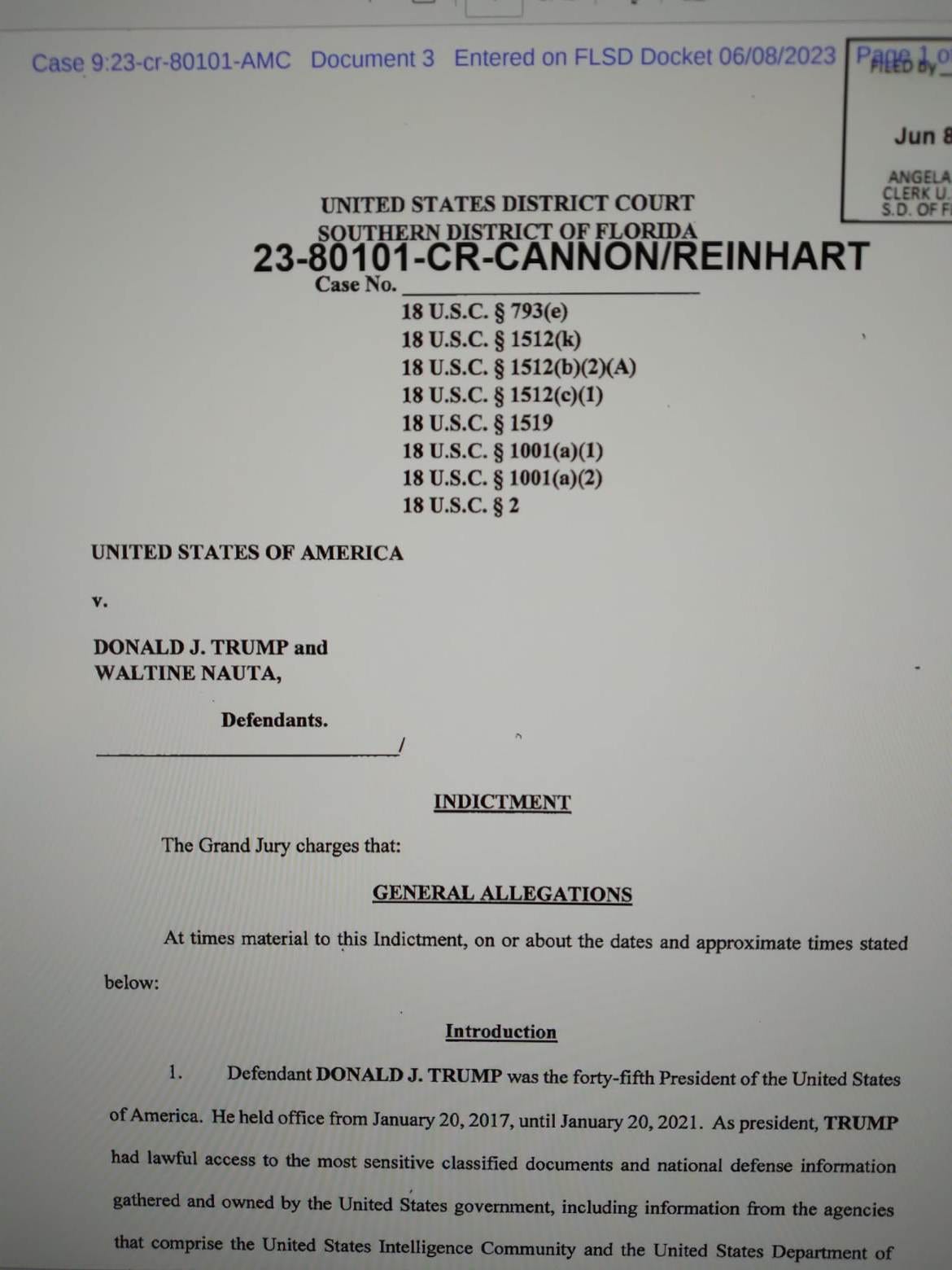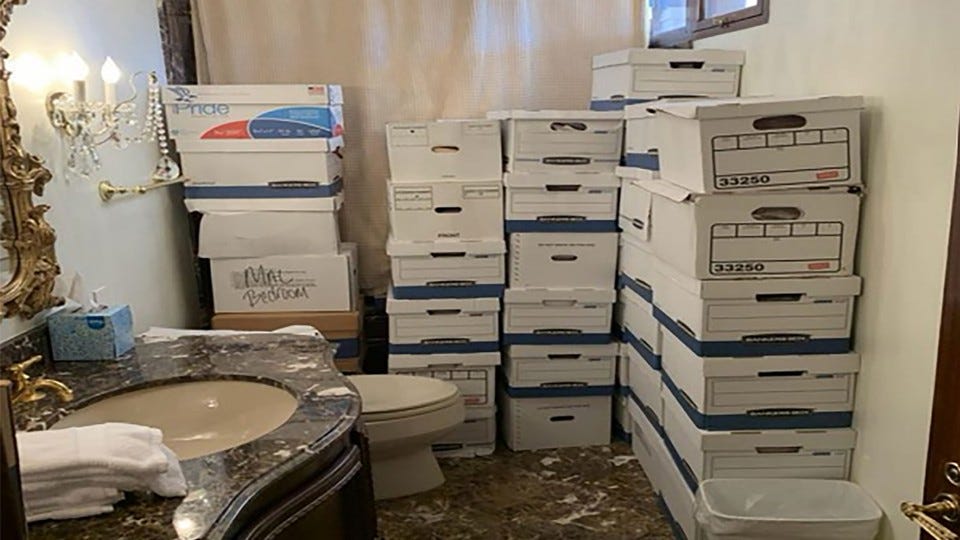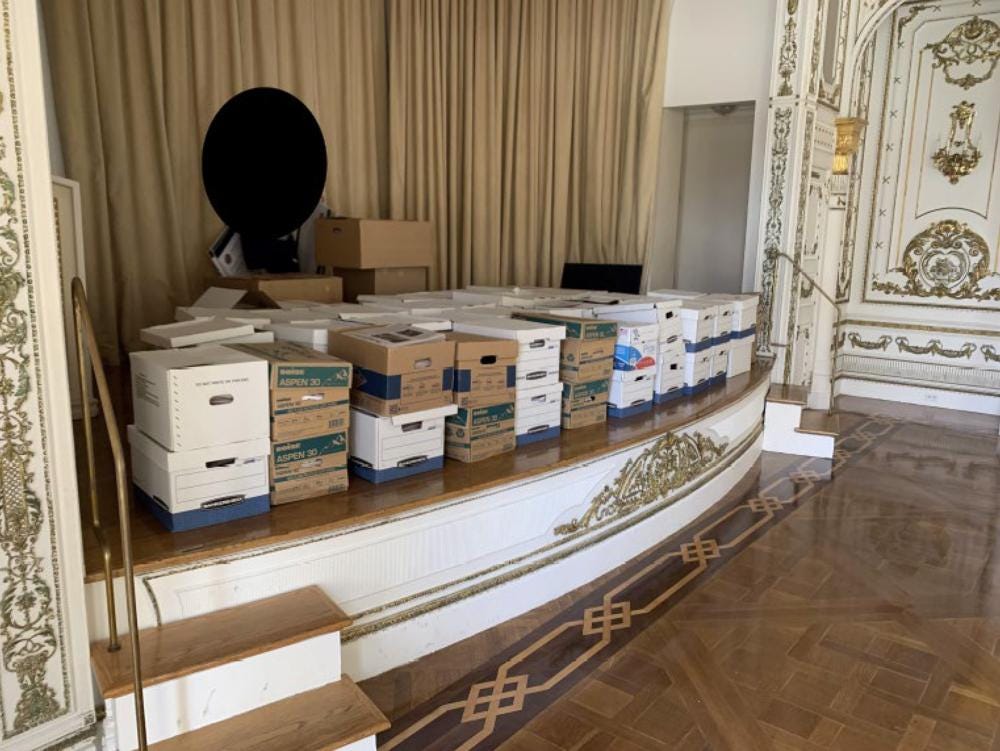38 counts and 49 pages: I read the Trump indictment so you don't have to
How do you describe this thing? Painstaking? Detailed? Stunning? Historic?
Another word that might apply for readers of this column is boring, because in a sense, we’ve heard it all before. We’ve been watching the Trump documents case, I guess we could call it, play out in real time since this time last year…and with some lag-time, since months before that when reports first began appearing that Trump had taken tons of stuff with him from the White House that he was supposed to turn over to the National Archives. Some of the stuff was gifts given to him or members of his family while he was president, some of it was said to be official papers – as the leaks emerged and the stories were printed, it rapidly became clear that Donald Trump didn’t think he had to do what other presidents had done, that he didn’t feel like the Presidential Records Act applied to him.
It didn’t take long for us to start hearing Trump use the word “my” or “mine” to describe the stuff he took to Mar a Lago when he left office. Now, in the indictment, we find the depth of that feeling spelled out in detail. For example, on May 23, after he had received the subpoena for “any and all” classified documents he had taken to Mar a Lago, Trump had a meeting with “Attorney 1,” who appears to be Evan Corcoran, because the notes he took that are referred to in the indictment are so detailed. Corcoran and another attorney were there to tell him that they had to search through the boxes of documents he took from the White House because they had to “provide a certification that there had been compliance with the subpoena.”
This is how the indictment says Trump responded to his lawyers’ having spelled out his obligations under the law:
“I don’t want anybody looking, I don’t want anybody looking through my boxes, I really don’t, I don’t want you looking through my boxes.”
“Well, what if we, what happens if we just don’t respond at all or don’t play ball with them?”
“Wouldn’t it be better if we just told them we don’t have anything here?”
“Well, look, isn’t it better if there are no documents?”
The indictment doesn’t give Corcoran’s or the other lawyer’s responses to Trump, but clearly they were telling him that he was going to have to respond to the subpoena with something, because Trump and Corcoran made plans for Corcoran to return to Mar a Lago on June 2 to search through Trump’s boxes for whatever he could find that was “responsive” to the subpoena.
The indictment takes what appears to be a pause to recount, from Corcoran’s notes, Trump telling a story about how Hillary Clinton’s famous emails came to be deleted. Trump told his two attorneys – we can only imagine their reaction – that he, Trump had heard from a lawyer who said he was the one who deleted her emails, because “they basically dealt with her scheduling and her going to the gym and her beauty appointments. And he was great…so she didn’t get into any trouble because he said that he was the one who deleted them.”
The indictment does not spell it out specifically, but clearly Trump was indicating that if his lawyers did something similar for him…if they somehow “deleted” by hiding his documents, he wouldn’t get in any trouble either.
Neither Corcoran nor the other lawyer bit on this Trumpian dangle because Trump told them he was going to delay his departure to his Bedminster Golf club so he could be there at Mar a Lago when Corcoran returned on June 2 to conduct the search of Trump’s boxes, and he wanted to be there on June 3, when the DOJ attorneys were supposed to show up at Mar a Lago to meet with Corcoran to receive whatever classified documents Corcoran had found in Trump’s boxes.
The indictment then lays out Trump’s plan after his attorneys left. It is one of the counts in the conspiracy to obstruct justice with his valet, Walt Nauta, who was also indicted. Between the May 23 meeting with his attorneys and June 2, Nauta removed from the storage room “at Trump’s direction, approximately 64 boxes and brought them to Trump’s residence, as set forth below:” Then the indictment lists the steps and details discovered from cell phone texts and the like.
On May 24, Nauta removed three boxes from the storage room.
On May 30, Trump spoke to Nauta on the phone for approximately 30 seconds, followed by Nauta moving 50 boxes from the storage room to Trump’s residence.
On June 1, Nauta removed approximately 11 boxes from the storage room.
Later that day, Trump spoke to Corcoran on the phone and asked him if he still planned to come to Mar a Lago the next day, and asked him “for what purpose,” according to the indictment. Corcoran told him he was coming to go through the boxes in the storage room so he could have a “custodian of records certify that the May 11 subpoena had been complied with fully.” This information could only have come from Corcoran during his grand jury testimony.
On June 2, Trump called Nauta and had him move approximately 30 boxes from Trump’s residence back to the storage room. “So in sum,” the indictment says, Trump had ordered Nauta to move 64 boxes to his residence and returned only 30 to the storage room. “Neither Trump nor Nauta informed Attorney 1 of this information.”
Later on June 2, Corcoran showed up at Mar a Lago, and Nauta escorted him to the storage room, where Corcoran went through the boxes that were there and discovered 38 classified documents. Corcoran put the documents in a “Redweld folder” and had Nauta bring him some clear duct tape, and he sealed the folder.
Corcoran met with Trump in a Mar a Lago dining room to report that he had completed his task. Trump asked him, “Did you find anything? Is it bad…is it good?” They discussed what Corcoran should do with the folder overnight. After all, Corcoran had told Trump he had found 38 classified documents. The indictment then quotes Corcoran’s notes of the conversation:
“He made a funny motion as though—why don’t you take them with you to your hotel room and if there’s anything really bad in there, like, you know, pluck it out. And that was the motion that he made. He didn’t say that.”
This was the folder that we know from numerous retellings of this tale, many of them by yours truly, that Corcoran handed over to Jay Bratt on June 3. Trump knew exactly what was in that folder, because he had spent 10 days going through the boxes in his residence, and he had specified to Nauta which 30 boxes to return to the storage room – the boxes that he knew Corcoran would “search” on June 2 – and he knew exactly what was in them…and what wasn’t in them.
What we didn’t know was this: Trump met with “personnel from the Department of Justice and the FBI” later in the day on June 3 and told Jay Bratt and his FBI agents that he was, according to the indictment, “an open book.”
After that, Trump had Nauta and several other aides load “several of Trump’s boxes” onto the aircraft on which he was flying to Bedminster, and he took off.
We know what happened next. The FBI had a look at some of the Mar a Lago surveillance footage they had subpoenaed and went to a federal judge and got a search warrant, and on August 8, they searched Mar a Lago and found 102 additional classified documents, some in the storage room, and some in Trump’s office, obviously because after the FBI and Bratt left on June 3, Trump had Nauta move the boxes he had hidden in his residence back into the storage room, not thinking that something as incredible as an FBI search would later turn them up.
I have concentrated here on this scene which makes up some of the obstruction of justice conspiracy counts. But the indictment is worth reading yourself. There is a whole section which just spells out as clearly as the DOJ could, without jeopardizing national security, the nature of the classified documents Trump kept at Mar a Lago. And the indictment takes the time, as part of several counts of violating the Espionage Act’s bar against mishandling national security information and not storing it properly and keeping it in a place where persons without security clearances might see it, to show where Trump kept his boxes of top-secret documents. One place was a bathroom in something called “The Lake Room,” shown here:
And the other place was on the stage of The White and Gold Ballroom at Mar a Lago, during a time, the indictment points out, when “events were held there.”
The list of sensitive documents is, I have to use this word, stunning. Some of them include “military activities and planning of foreign countries;” “military contingency planning of the United States;” “nuclear weaponry of the United States;” “timeline and details of an attack in a foreign country;” “foreign country support of terrorist acts against the United States;” and “communications with a leader of a foreign country.”
I leave it to your imagination what Trump wanted these documents for, what he might have done with them, to whom he might have shown them, and why he went to so much trouble to keep from returning them to the National Archives where they belong. We get a hint about the use of one document in one of the 38 counts against Trump in the meeting with the interviewers in Bedminster when he waved around what he claimed were plans to attack Iran that General Mark Milley had allegedly drawn up. Since that story came out, Milley has denied he gave such a document to Trump and that he had any role in producing it.
There are many counts of Trump and his co-conspirator Nauta “willfully and corruptly concealing a document with an intent to impede or obstruct and interfere with the investigation…” and so forth and so on. Busy, busy, busy they apparently were.
And now busy, busy, busy Trump will be with the new attorneys he has announced that he hired since Corcoran is gone, and so are the two guys who wrote the letter to Merrick Garland accusing him of engaging in a “lawless” investigation of Donald Trump.
That’s the other thing we learn from these 49 pages and the 38 counts of committing federal crimes. Donald Trump knows from lawless.




I read the indictment, but all I can think of right now is that Judge Aileen Cannon will be the trial judge, it appears.
This is a very serious blow to the prosecution.
I have gone from giddy to extremely cynical and depressed at this news because to me, this assignment of judges was not as random as everyone seems to think, because there are 15 district judges in that court, and why she came up as the trial judge (everyone thinks she's temporary, but I don't believe it..) for the one trial that could send Donald Trump to prison is just a bit more than I can bear to think about.
Excuse me while I am being negative. I will see you all later. I've had my fill of Trump and the corruption that attaches to the man.
"Everything Donald Trump touches, dies."
My Navy Attack Squadron had missions to fulfill should we go to war with USSR or Communist China: it was called SIOP, Single Integrated Operational Plan (Nuke war plan of attack). Everyone in my squadron thought that they were basically Kamikazee missions.
As the junior officer in my squadron I was sent to San Diego for the Registered Publications Officer---the guy responsible for all Confidential, Secret, Top Secret, and Top Secret ESI (Extremely Sensitive Information) stuff. You screw up, you went to military prison. People's lives were ruined because they mishandled this stuff---it was drop dead serious in those days.
The stuff Trump kept is TS-ESI. He, and many of his staff, should go to prison for his breeches of security.
One would have to have been in the military and involved in Top Secret things to know how Trump really acted in a criminal and traitorous way. To intelligence people this is drop dead serious stuff.